Nature
Protecting nature means protecting the climate
52 million tons – that is how much CO2 German forests relieve the earth's atmosphere on average each year. That is more than a third of the emissions produced by traffic in this country in 2020 (146 million tons).
In short: We need forests to counteract air pollution in Germany and protect the climate.
Photosynthesis
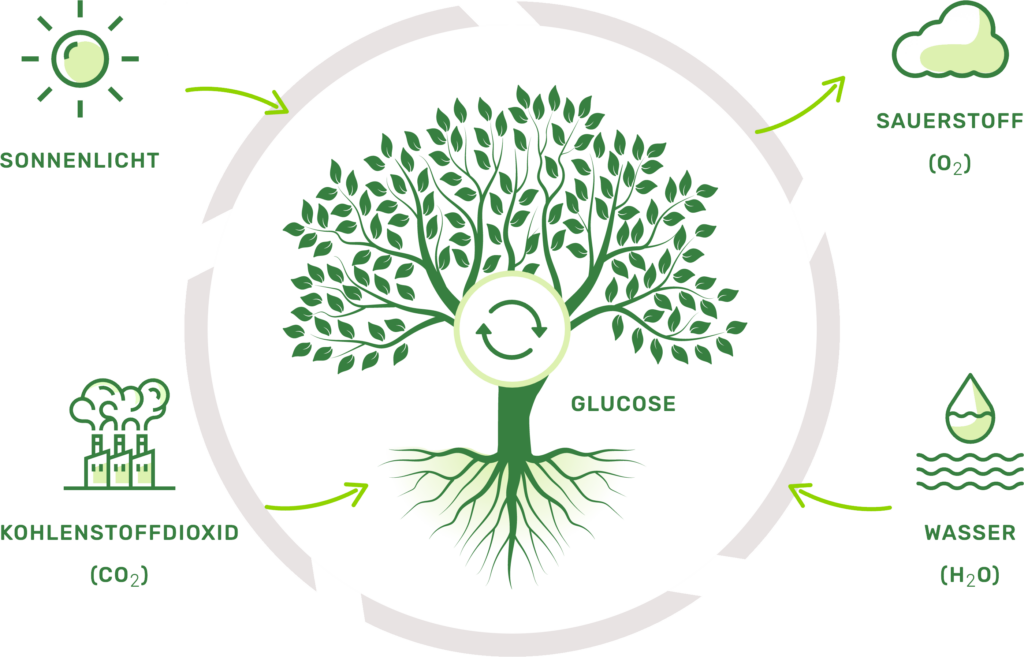
Pflanzen absorbieren über Farbstoffe in ihren
Blättern und Nadeln Sonnenlicht. Dieses dient als
Energiequelle für eine einzigartige biochemische
Reaktion, in der die Pflanzen Lichtenergie chemisch
binden. Das ist nötig, damit sie schließlich aus
Kohlenstoffdioxid und Wasser lebenswichtige
Nährstoffe synthetisieren können.
Des einen Abfallprodukt, des anderen
Lebenselement: Hat ein Baum die Energie chemisch
gebunden, gibt er den dabei entstandenen, für den
Baum aber nutzlosen Sauerstoff an die Umgebung
ab. Übrigens: Allein eine ausgewachsene Buche
produziert im Jahr mehr als vier Tonnen Sauerstoff,
genug für den Sauerstoffbedarf von zehn bis
zwanzig Menschen im gleichen Zeitraum!
Dieser Traubenzucker ist Ziel und Ergebnis der
Fotosynthese. Er dient Pflanzen als Ausgangsstoff
für die Synthese von Fetten und Eiweißen. Zudem
können sie ihn in Stärke umwandeln, die schwer
löslich ist und auch bei Wasserverlust in der Pflanze
verbleibt.
Meist genügt schon die Luftfeuchtigkeit für die
Fotosynthese. Ist der Boden zu trocken, schließen
sich aber auch die Spaltöffnungen der Blätter, um
die weitere Austrocknung zu stoppen – damit kann
die Pflanze auch kein CO2 mehr aufnehmen, die
Reaktion stoppt.
Die Pflanze bindet das CO2 aus ihrer Umwelt. Dabei
kommt es auf die richtige Atmosphäre an: Zu wenig
CO2 verhindert die Reaktion, zu viel hindert sie je
nach Art bei anderen lebenswichtigen Prozessen,
etwa der Aufnahme von Stickstoff aus dem Boden.
The forest is dying. Let's save him!
Our forests have often existed for many decades or even longer. But we cannot take them for granted - they themselves now need protection. Forest dieback is in full swing. Why is that?
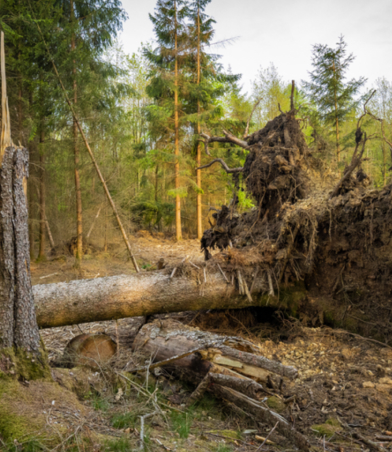
Climate change
As the climate changes, so does the weather: extreme conditions such as storms, heat waves or cold spells are becoming more common. 2018 and 2019 were exceptionally dry and hot – 2018 was even the warmest year in Germany since weather records began. This has a major impact on the sensitive ecosystem, such as a higher risk of forest fires due to long dry periods.

Pests
Climate change is causing soils to dry out and lose important nutrients. This makes trees vulnerable to pests. The most well-known of these is the bark beetle and its notorious subspecies, the spruce bark beetle. Its mass reproduction is disrupting the balance of forests in many regions, with serious consequences for tree populations.
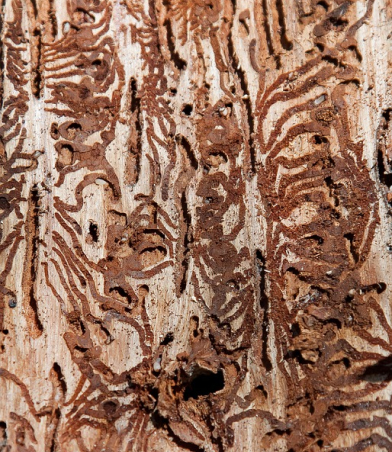
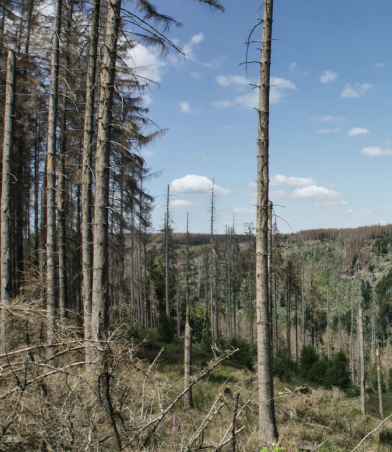
A DANGEROUS DOWNWARD SPIRAL
Climate change and new pests are weakening the forest, meaning the trees are absorbing less CO2 in their wood. This in turn is accelerating global warming – a real vicious circle with consequences for every living creature on our planet.
How well are our forests doing?
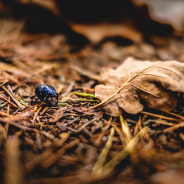
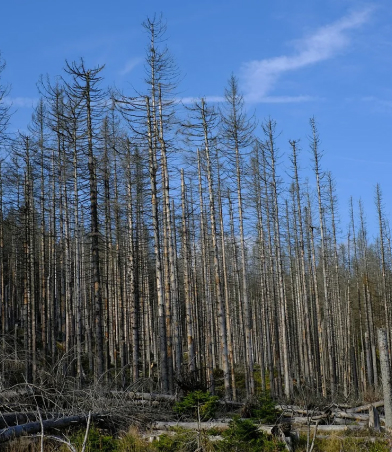
Year: 1984
Damaged trees: 56 %
Year: 2020
Damaged trees: 78 %


1984
2020
Moors – often forgotten, just as worthy of protection
Our moors have existed for over 12,000 years, but they are more relevant today than ever before.
JUST LIKE THE FOREST, OUR MOORS ALSO STORE A LOT OF CO2.
According to BUND, this is around twice as much as all forests combined. In addition, moors are home to many plants and animals and thus contribute to biological diversity. Moors are also essential for flood and groundwater protection.
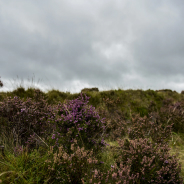
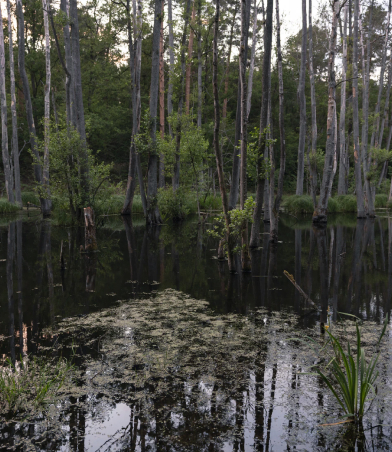
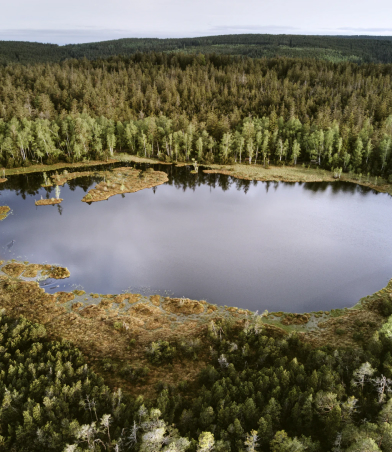
MOORS ONLY EXIST WHERE THERE IS SUFFICIENT WATER.
This allows organic residues to settle without breaking down. Eventually they become peat. To date, 99 percent of all German moors have been drained or mined for agricultural or forestry use. We are committed to protecting the last percent from this.

Donate money, protect forests, wildlife and climate
Given this development, it is high time to act. Together we are laying the foundation for a sustainable future in our country and on our planet.
PMT-FONDATION. The foundation is actively committed to German forests and natural areas and thereby supports environmental protection. With your donation you enable us, among other things, to acquire new nature conservation areas, reforest forests and maintain them. In this way you help to reduce greenhouse gas emissions in the long term and to preserve local biodiversity.
